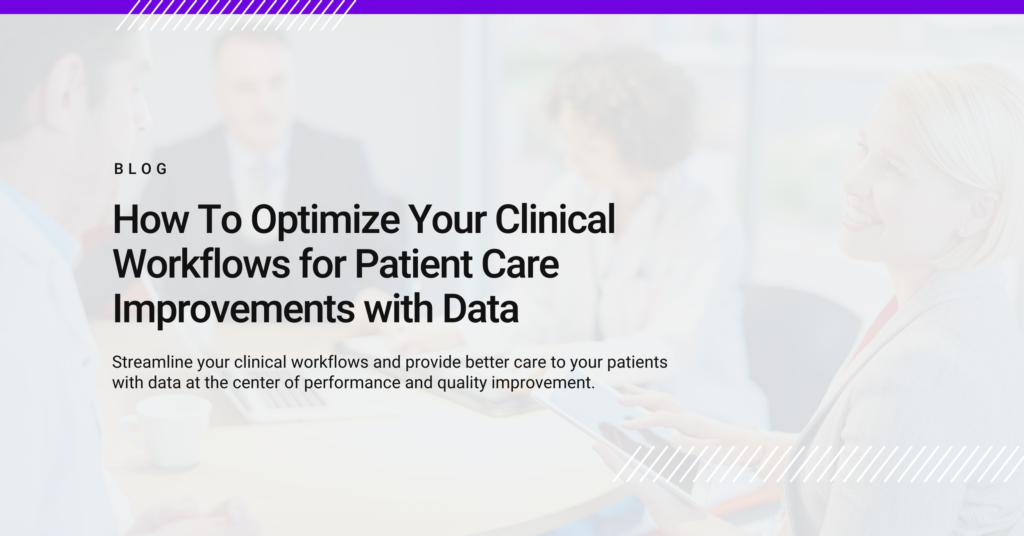Clinical workflows play a critical role in the delivery of high-quality patient care. But time-to-insight for improvement projects is often slow-moving because finding answers or accessing data is a long process.
It doesn’t have to be this way. By asking the right questions, putting the right tools in place, and committing to implementing your new ideas, you can streamline your clinical workflows and provide better care to your patients with data at the center of performance and quality improvement projects.
STEP ONE
Audit Your Current Clinical Workflows
Taking the time to identify inefficiencies and bottlenecks that are holding you back will lay the groundwork for making an impactful process improvement. It’s no secret that the industry as a whole has been in a whirlwind of adaptation and quick innovation–especially throughout the last three years. However, noticing the overall pain points of your organization’s clinical workflows can greatly affect the health system at large.
To get started, select a topic. Popular audit topics fall into the realms of procedures, treatments, and overall investigations. Anytime there is a patient journey through departments of a health system, there is an opportunity to improve the quality of the care they receive.
After the topic has been selected, it’s key to have team members on board to assist in setting the goal of what you are aiming to achieve. It is also important to determine the objectives and the standards that are put in place through the organization’s code of ethics and values of care which have been long established.
STEP TWO
Empower Your Teams
Once your team is established, they will begin sampling and collecting data that aligns with the goals and objectives. This is where abiding by the code of ethics will play an important role. As we all know, patient privacy is extremely important. However, we also know that IT departments are swamped, and by the time you get your data set back from your original query, more information has most likely been discovered which means you have to resubmit the data request. This process takes time, but it doesn’t have to be as long as it has been for the past few decades. When there is technology in place leading you to answers faster without sacrificing patient privacy or data quality, the efficiency of quality and performance improvement can accelerate.
Good clinical workflows are all about working together as a team. Foster a culture of collaboration and encourage regular communication between team members. This also includes enabling your professionals to do their jobs and empowering them to utilize tools (and data) to do the job well. By setting them up for success as a team, and as an individual, you will cover more ground to ask more questions, discover more insights, and act on implementing improved workflows to better serve your patients.
STEP THREE
Embrace Technological Solutions for Support
So, how do you empower your teams to ask questions and collect data to support your audit project when they have to depend on so many other professionals and teams to find answers?
Technology is a powerful tool that can help you work smarter, not harder. There is software for just about anything and leveraging the latest tools and technologies can make life easier for your audit and for overall healthcare professionals within the organization, too.
An example of this would be a software platform that allows any user—with or without a technical background of data analysis—to ask questions and form queries to support a hypothesis while being flexible enough to organically change and adapt as the project takes its shape. The same software would also have high enough security to safeguard patient privacy, as well as access data across multiple departments of the health system, and even integrate with third parties.
MDClone’s ADAMS Platform does just that. By creating synthetic data based on real patient populations within the health system’s data lake, a sandbox is created to allow healthcare professionals the ability to search and build upon their ideations.
The Ultimate Guide to Synthetic Data →
STEP FOUR
Eliminate Inefficiencies
Once you have a clear understanding of the challenges you’re facing, it’s time to eliminate inefficiencies, simplify procedures, and make life easier for your healthcare professionals. Having data-backed points that support your improvement of your audit topic will help in your presentation for change, and will support the facts needed to apply for funding, create implementation plans, and integrate improvements into your system. With more time for healthier patients and less time for staff frustration, you’ll see an immediate impact in the quality of care you provide.
STEP FIVE
Measure & Evaluate Processes (Regularly)
Last, but certainly not least, is measuring your outcomes. Continuously monitor and evaluate your new and improved clinical workflows. Seek feedback, track key metrics, and make regular adjustments as needed. Quality and process improvement are living, ever-changing workflows that need to be evaluated consistently. By designating time, making quality and performance improvement a priority, and putting findings into meaningful action, you can ensure that your patients receive the best possible care.
Data can accelerate improvements
Streamlining clinical workflows is an ongoing process that requires a commitment to improvement and a willingness to embrace change. Data, and easier access to data, can help build a continuous learning system with healthcare staff seeking answers to improved processes. Technology can help, but healthcare staff are the ones who will power change.
The benefits are clear: healthier patients, happier healthcare professionals, and a better-functioning healthcare organization.










